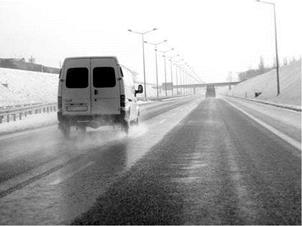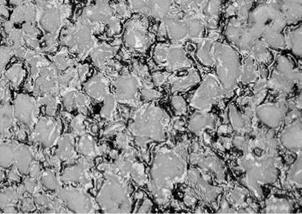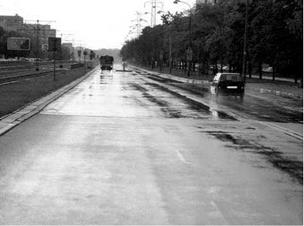Airport in Frankfurt on the Main
One of the best-known applications of an SMA mixtures for airfields is the northern runway of the airport in Frankfurt on the Main (Fraport). It has become famous not only because of the SMA application but also because of the atypical arrangement of the reconstruction of the runway pavement. The 2-year long removal of the worn-out concrete pavement and the laying of a new asphalt structure was completed in 2005.
Fraport is one of the largest airports in the world, with a colossal traffic capacity and an impressive number of takeoffs and landings—more than 200,000 per year. The replacement of the northern runway pavement was carried out exclusively at night to reduce reconstruction-related air traffic problems. This necessitated organizational and technological arrangements to complete each stage of the reconstruction work early in the morning. The intended entrance to the work site was at 10:30 p. m. on a given night, followed by the first landing at 6:00 a. m. next day. The scope of work was divided into independent day lots (actually night lots), which had to be executed within a 7.5-hour break in takeoffs and landings.
The runway intended for rebuilding was 4000 m long and 60 m wide, for a total of 240,000 m2. The working lot reconstructed over one night was 15 m long. It took 300 nights to accomplish the pavement replacement. Work was started near the end of April 2003 and finished in June 2005. The old structure of the runway pavement comprised a set of cement concrete layers. All the new asphalt layers contained polymer modified bitumen (PmB) 25 or PmB 45, according to the German guidelines for modified binders TL PmB 01. They were additionally supplemented with Fisher-Tropsch wax (Sasobit) to lower the compaction temperature of the asphalt. The Sasobit additive made possible the compaction of the asphalt mix at a lower temperature (usually at approximately 130°C) and faster cooling of the wearing course (the temperature after laying and compaction was about 100°C); this was critical since the mat had to cool within 1.5 hours prior to the first landing or takeoff at 6 a. m. The SMA 0/11 wearing course was 40 mm thick. Limestone with a hydrated lime additive was used as a filler. The SMA wearing course was spread at a speed of 5 m/min. Seven rollers were engaged in compacting the mat. At the moment of the first landing, the temperature of the pavement ranged between 52 and 79°C (Sasol GmbH, undated).
The replacement of Fraport’s northern runway pavement was successfully completed. At the same time it became one of the best-known runway reconstruction projects carried out without the disruption of transport services.






![Test Results Подпись: 03 4 5 6 7 8 9 10 11 12 13 14 15 Air void content, % v/v FIGURE 12.10 Water permeability of SMA mixtures with gradation 0/4.75, 0/9.5, and 0/12.5 mm, depending on the size of the selected breakpoint sieve—the degree of gap gradation. (From Cooley, L.A. Jr. and Brown E.R., Potential of Using Stone Matrix Asphalt [SMA] For Thin Overlays. National Center for Asphalt Technology, Auburn University, NCAT Report 03-01, April 2003. With permission.)](/img/1312/image249_1.gif)


